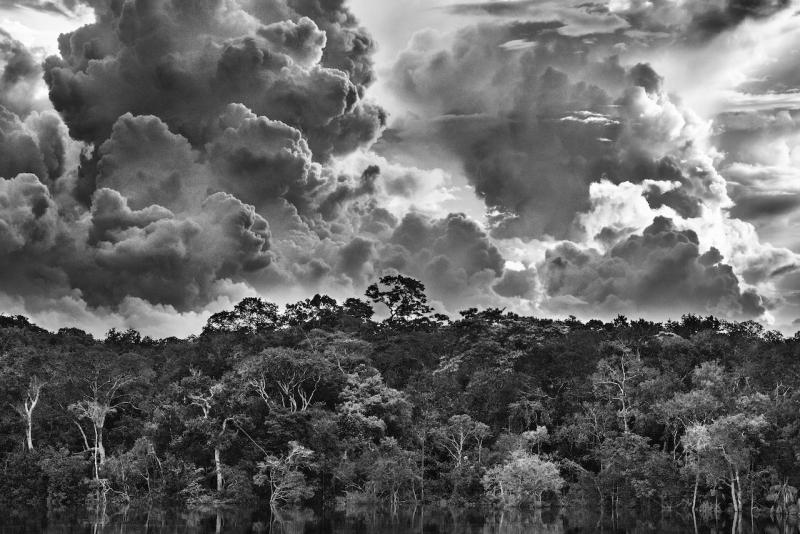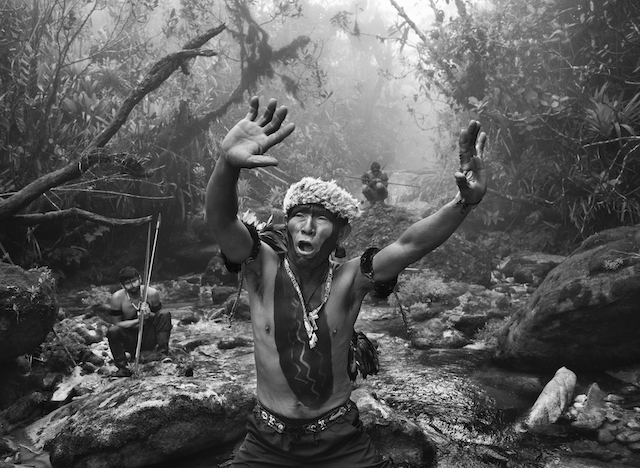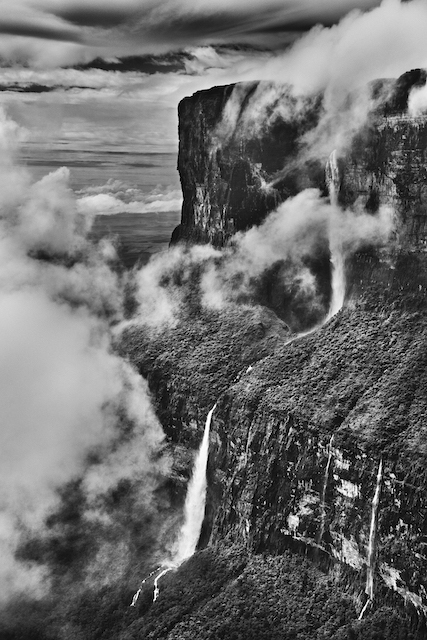Documenting the unimaginable: photographer Sebastião Salgado talks about climate change, dodging caimans and changing perspectives | reviews, news & interviews
Documenting the unimaginable: photographer Sebastião Salgado talks about climate change, dodging caimans and changing perspectives
Documenting the unimaginable: photographer Sebastião Salgado talks about climate change, dodging caimans and changing perspectives
How does Western behaviour risk turning the Amazonian paradise into a hell?

Sebastião Salgado has carved out his career by documenting the unimaginable. He takes areas of life all too often ignored by wealthy westerners and reveals them in mesmerising, teeming detail.
To look at one of his photographs is to experience the world not just through the eyes but through the mind of a man for whom everything is interconnected. Whether it’s a Mumbai commuter or a Brazilian gold-digger, a giant tortoise in the Galapagos or a worker covered in oil in Kuwait, each subject is revealed as a vital part of a planet that’s as turbulent as it is miraculous.
He was in his twenties when he first picked up a Pentax Spotmatic II. It was the 1970s, he had completed a PhD on the economics of coffee and was working for the World Bank on agricultural development projects in Central and East Africa. He had grown up on a farm in Brazil, but at this stage of his life his beard and intense stare made him look more like an apparition from Norse mythology. His late teens had been spent studying in Vitoria, where he met Lélia Wanick, who would become his lifelong partner and collaborator. “I do not know where she ends and I begin,” he tells me. Both became politicised by witnessing the plight of rural migrants flocking to the city; after marrying they moved to San Paolo.
It was there that their affiliation with the Marxist-leaning group Popular Action brought them under the scrutiny of the military dictatorship which had staged a coup in Brazil in 1964. Friends and comrades were tortured or “disappeared” by the regime; in 1969 as the danger whispered closer they escaped to Paris where Salgado began his PhD in the economics of coffee and Lélia studied architecture. It was she who bought the Pentax, but Salgado who quickly realised that it allowed him to tell the stories he was witnessing through his work in a language that would be more widely understood than any economics report. “In some situations you ask yourself,” he confesses, “whether you should be taking photographs any more or you should put your camera in the ground and cry. Yet when you immerse yourself in people’s lives, you can see that even when there is intense suffering there can also be compassion and joy.”

We meet at the opening of his powerful exhibition Amazônia at the Science Museum, which features 200 images created over more than a seven-year period of journeys into the Brazilian rainforest. Salgado refuses to be clamped down by the description “activist photographer”, yet there is no doubt that the exhibition is a call-to-action as he exhorts the gathered press neither to buy from, nor invest in companies that are ravaging the Amazon’s resources. At the age of 77, he has lost the hair but not the passion or vigour of the man whose early books brought a new immediacy to the struggles of industrial workers and migrants. Lélia, who has conceived and designed his books and exhibitions since he started, has also curated this latest display. Before he gives his speech, he stands behind her with his arms around her; the ease of their connection makes them look like some latter-day Philemon and Baucis.
When he talks to me, he is emphatic that he did not create the book Amazônia – on which the exhibition is based – to be part of the debate on climate change. “It’s always tempting to impose patterns with hindsight,” he says. “People told me that my photographs of workers were published as part of the conversation about de-industrialisation; that my book Exodus was released for when migration was the big issue. But the fact is that I’m living my life during a certain historic moment, so when I create a series of photos inevitably they become representative of patterns of the time.” It’s also, you might argue, because of Salgado’s dedication to digging beyond the superficial so he can fully inhabit the communities he’s portraying in his projects. It took him six years of visiting 26 countries to put together the images for Workers: An Archaeology of the Industrial Age and another six – during which he visited 40 countries – to collate Exodus.
Now his images are so infamous it’s difficult to imagine what it must have been like to be the art director of the Sunday Times on the day in 1986 when the then little-known Salgado’s pictures of the Serra Pelada goldmine landed on the desk. He was not the only photographer to have documented the Brazilian mine; a number of other photojournalists had taken colour pictures over the course of a couple of days there. The crucial difference was that Salgado had spent four weeks living and working with the people he photographed before recording their story in what would become his trademark monochrome. As Neil Burgess, the director of Magnum’s London office who handled the images later said, it was “an epic poem in photographic form”. At a point when many editors were embracing colour photography, the teeming figures scaling a hellish pit on rickety ladders had a simultaneously timeless and immediate quality that reinvented the way black and white images could have impact.
His subsequent propulsion to notoriety has – inevitably – brought detractors over the years. The stunning composition of his photos has provoked accusations of romanticism and inauthenticity. He has also courted suspicion through what some have criticised as the aestheticisation of suffering. In Regarding the Pain of Others Susan Sontag denounced Exodus’s “focus on the powerless, reduced to their powerlessness”.
Yet it doesn’t take much examination of his work and his modus operandi to conclude that there is nothing slick, patronising or romantic about what he does. His interest in the oppressed clearly comes from a Marxist sensibility and is given rigour by his expertise in economics. The months he then spends building relationships with his subjects is intrinsic to the emotional power of what he chronicles. Each image he creates is therefore informed by both a macro and micro perspective; while he is in a constant process of interrogating the forces shaping our world, he is also profoundly engaged with the story of each individual he encounters. When he took photographs of the civil war in Rwanda for the book on migration so derided by Sontag, he was so devastated by what he witnessed that his immune system collapsed and he was forced to retreat from photography.
 Though much of his work has been focused on the developing world, he is explicit that the developed world has no room for complacency. Discussing a series of photos he shot in the Sahel he says, “These people have no food, but does that make them more wretched than – say – a person living alone in a derelict flat in London with no-one coming to see them, with nothing to live for?” He has talked in the past about 9/11 being the point when the West started to wake up to the fact that – as his images repeatedly point out – the whole world is interconnected, and that we ignore hardship and struggles in other countries at our peril. “We need to go beyond individualism – we need to understand that we are just one small part of a planet with billions of people and it is important to take the time to engage with this.”
Though much of his work has been focused on the developing world, he is explicit that the developed world has no room for complacency. Discussing a series of photos he shot in the Sahel he says, “These people have no food, but does that make them more wretched than – say – a person living alone in a derelict flat in London with no-one coming to see them, with nothing to live for?” He has talked in the past about 9/11 being the point when the West started to wake up to the fact that – as his images repeatedly point out – the whole world is interconnected, and that we ignore hardship and struggles in other countries at our peril. “We need to go beyond individualism – we need to understand that we are just one small part of a planet with billions of people and it is important to take the time to engage with this.”
His collapse marked a turning point; in its aftermath he and Lélia returned to Brazil to the farmland where he had grown up. Like him it was sick – ravaged by intense farming practices. As they contemplated a future there, Lélia suggested that they rewild it. As with so many decisions in their life this was a counterintuitive move and locals were highly sceptical.
Yet in 1999 they went ahead and planted seeds from 300 tree species. Despite some early reversals of fortune, they have now seen 17,000 acres transformed into a lush landscape with four million trees. As the forest has grown, formerly dried-up springs have started to flow again, and hundreds of species of animals and plants have returned. Part of the Amazônia exhibition at the Science Museum is devoted to what is now known as the Instituto Terra.
Having proved, not for the first time, that he could put his money where his mouth is, Salgado returned to photography to seek out the parts of the world that humanity had not managed to destroy. This was an investigation of the animals, plants and indigenous tribes that led an existence unimpacted by industrialisation. After a process that took eight years, Genesis came out in 2013. It was heralded by critics as a “stupendous enterprise”, not least for a scope that ranged from the Patagonian prairies to the ice-ravaged landscapes of Siberia, and a focus that could equally embrace the detail of an iguana’s claw or the progress of a whale.
Amazônia continues its trajectory and is a love letter to the landscape of his birth; he describes it as “the last frontier, a mysterious universe of its own, where the immense power of nature can be felt as nowhere else on earth”. Though he is a young and healthy 77 he believes that will be his last major work. Each project he has done has carried considerable physical risk; this time he reveals, “I broke my knee twice and had to have a big operation.” He also almost lost an eye. As he told a journalist, with some relish, he couldn’t swim in the Amazon because of the risk of being devoured by caimans or piranhas. Beyond this there were constrictor snakes to avoid.
Yet Salgado feels he has captured a paradise: both through the lifestyles of the tribes that he photographed – some of whom had not been contacted by any outsider before – and the landscape portrayed. And whatever the word games he may play about activism, he wants us to look at these images and ask ourselves profound questions about how what we do five and a half thousand miles away might turn it into a hell. “When you take photographs you work with light and shadow, with a sense of space and composition which must all be well calibrated to create a good image,” he declares. “But you are not a photographer if you don’t work to raise questions about your society. What’s happening inside your head is every bit as important as what you can see in front of you.”
Explore topics
Share this article
The future of Arts Journalism
You can stop theartsdesk.com closing!
We urgently need financing to survive. Our fundraising drive has thus far raised £49,000 but we need to reach £100,000 or we will be forced to close. Please contribute here: https://gofund.me/c3f6033d
And if you can forward this information to anyone who might assist, we’d be grateful.

Subscribe to theartsdesk.com
Thank you for continuing to read our work on theartsdesk.com. For unlimited access to every article in its entirety, including our archive of more than 15,000 pieces, we're asking for £5 per month or £40 per year. We feel it's a very good deal, and hope you do too.
To take a subscription now simply click here.
And if you're looking for that extra gift for a friend or family member, why not treat them to a theartsdesk.com gift subscription?
more Visual arts
 'We are bowled over!' Thank you for your messages of love and support
Much-appreciated words of commendation from readers and the cultural community
'We are bowled over!' Thank you for your messages of love and support
Much-appreciated words of commendation from readers and the cultural community
![SEX MONEY RACE RELIGION [2016] by Gilbert and George. Installation shot of Gilbert & George 21ST CENTURY PICTURES Hayward Gallery](https://theartsdesk.com/sites/default/files/styles/thumbnail/public/mastimages/Gilbert%20%26%20George_%2021ST%20CENTURY%20PICTURES.%20SEX%20MONEY%20RACE%20RELIGION%20%5B2016%5D.%20Photo_%20Mark%20Blower.%20Courtesy%20of%20the%20Gilbert%20%26%20George%20and%20the%20Hayward%20Gallery._0.jpg?itok=7tVsLyR-) Gilbert & George, 21st Century Pictures, Hayward Gallery review - brash, bright and not so beautiful
The couple's coloured photomontages shout louder than ever, causing sensory overload
Gilbert & George, 21st Century Pictures, Hayward Gallery review - brash, bright and not so beautiful
The couple's coloured photomontages shout louder than ever, causing sensory overload
 Lee Miller, Tate Britain review - an extraordinary career that remains an enigma
Fashion photographer, artist or war reporter; will the real Lee Miller please step forward?
Lee Miller, Tate Britain review - an extraordinary career that remains an enigma
Fashion photographer, artist or war reporter; will the real Lee Miller please step forward?
 Kerry James Marshall: The Histories, Royal Academy review - a triumphant celebration of blackness
Room after room of glorious paintings
Kerry James Marshall: The Histories, Royal Academy review - a triumphant celebration of blackness
Room after room of glorious paintings
 Folkestone Triennial 2025 - landscape, seascape, art lovers' escape
Locally rooted festival brings home many but not all global concerns
Folkestone Triennial 2025 - landscape, seascape, art lovers' escape
Locally rooted festival brings home many but not all global concerns
 Sir Brian Clarke (1953-2025) - a personal tribute
Remembering an artist with a gift for the transcendent
Sir Brian Clarke (1953-2025) - a personal tribute
Remembering an artist with a gift for the transcendent
 Emily Kam Kngwarray, Tate Modern review - glimpses of another world
Pictures that are an affirmation of belonging
Emily Kam Kngwarray, Tate Modern review - glimpses of another world
Pictures that are an affirmation of belonging
 Kiefer / Van Gogh, Royal Academy review - a pairing of opposites
Small scale intensity meets large scale melodrama
Kiefer / Van Gogh, Royal Academy review - a pairing of opposites
Small scale intensity meets large scale melodrama
 Jenny Saville: The Anatomy of Painting, National Portrait Gallery review - a protégé losing her way
A brilliant painter in search of a worthwhile subject
Jenny Saville: The Anatomy of Painting, National Portrait Gallery review - a protégé losing her way
A brilliant painter in search of a worthwhile subject
 Abstract Erotic, Courtauld Gallery review - sculpture that is sensuous, funny and subversive
Testing the boundaries of good taste, and winning
Abstract Erotic, Courtauld Gallery review - sculpture that is sensuous, funny and subversive
Testing the boundaries of good taste, and winning
 Edward Burra, Tate Britain review - watercolour made mainstream
Social satire with a nasty bite
Edward Burra, Tate Britain review - watercolour made mainstream
Social satire with a nasty bite
 Ithell Colquhoun, Tate Britain review - revelations of a weird and wonderful world
Emanations from the unconscious
Ithell Colquhoun, Tate Britain review - revelations of a weird and wonderful world
Emanations from the unconscious

Add comment